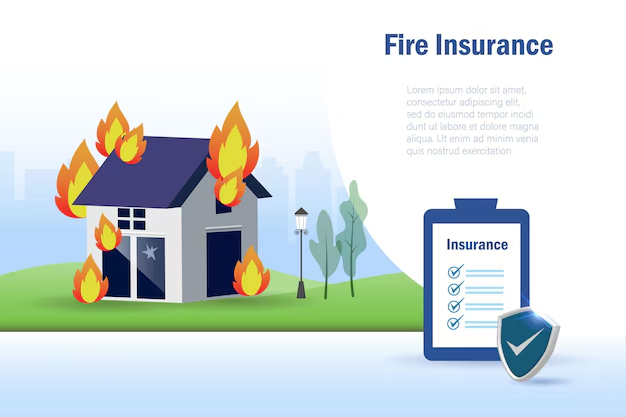Why Fire Insurance Coverage Matters
You come home after a long day, only to find smoke filling the air and firefighters battling flames near your property. Even if you’ve never personally lived through a house or business fire, just imagining it is enough to feel the weight of what’s at stake. Fires can destroy not only buildings but also memories, livelihoods, and financial stability in a matter of minutes. That’s why fire insurance coverage isn’t just another line on your policy; it’s a lifeline.
For many people, though, fire insurance feels like a vague promise. What does it actually cover? Will it replace everything? Are there loopholes that could leave you struggling during recovery?
In this guide, we’ll break down fire insurance coverage in plain language, explore real-world examples, and share expert tips to help you understand what you’re really paying for.
Why Understanding Fire Insurance Coverage Is Critical
Fires don’t discriminate. They strike homes, small businesses, and even large corporations. According to the National Fire Protection Association (NFPA), U.S. fire departments respond to over 350,000 home structure fires each year. These incidents cause billions in property damage.
But here’s what often gets overlooked: not all fire insurance policies are created equal. Some people discover too late that their coverage doesn’t extend to certain causes of fire or doesn’t fully replace lost belongings. That gap in understanding can mean the difference between a smooth recovery and financial ruin.
If you’re a homeowner, renter, or business owner, knowing the fine print of fire insurance is essential. It’s not just about protecting walls and roofs, it’s about securing your future.
How Fire Insurance Coverage Actually Works
At its core, fire insurance coverage is designed to compensate you for losses caused by fire. That sounds simple, but the details matter. Most standard home or business insurance policies already include fire coverage, though you can buy specialized fire insurance as an add-on for more protection.
When a fire damages your property, you file a claim with your insurer. The company investigates the cause of the fire, evaluates the extent of the damage, and then determines how much to pay out. Payments usually cover two main categories:
-
Property Damage – This includes the structure itself (walls, roof, foundation) as well as attached features like built-in cabinets.
-
Contents – Furniture, electronics, clothing, appliances, and other personal or business items lost in the fire.
But here’s the catch: some fires are covered fully, while others may not be. For instance, a fire caused by faulty wiring is usually covered. A fire resulting from intentional negligence (say, leaving a bonfire unattended) might not be.
What’s Typically Covered Under Fire Insurance
Fire insurance coverage usually extends far beyond just putting out flames. Policies often cover:
-
Building repair or reconstruction: If your house, apartment, or office suffers damage, the policy pays to fix or rebuild it.
-
Personal belongings: Clothes, electronics, furniture, and valuables lost in the fire are reimbursed up to your policy’s limit.
-
Additional living expenses (ALE): If your home becomes uninhabitable, many policies pay for temporary housing, meals, and even laundry services while repairs are underway.
-
Business interruption: For companies, fire insurance may replace lost income while operations are suspended due to damage.
-
Debris removal and cleanup: Clearing burnt materials and making the property safe again.
Here’s a comparison to illustrate coverage more clearly:
| Coverage Area | What’s Included | Example |
|---|---|---|
| Building | Structural repair/replacement | Rebuilding a burnt kitchen |
| Contents | Furniture, electronics, clothing | Replacing a destroyed laptop |
| ALE | Housing, food, transport | Paying for a hotel stay during repairs |
| Business Interruption | Lost income, temporary relocation | Covering payroll while shop is closed |
| Cleanup | Debris removal, sanitation | Hiring crews to remove burnt materials |
Common Exclusions: What Fire Insurance Doesn’t Cover
This is where many people get surprised. Fire insurance coverage isn’t unlimited, and exclusions can leave major gaps. Common exclusions include:
-
Intentional fires: Any fire set on purpose by the policyholder.
-
War or terrorism: Damage caused by acts of war or terrorism may require special coverage.
-
Vacant property: If a building is left vacant for a long time and a fire breaks out, the claim could be denied.
-
Electrical negligence: Failing to fix known hazards (like faulty wiring) may void coverage.
-
Earthquake- or flood-triggered fires: If a fire is caused by another excluded peril, it may not be covered.
That’s why experts always recommend reading the fine print carefully and asking your insurer about gray areas.
Real-Life Examples: When Fire Insurance Saves the Day
I once spoke with a small café owner whose entire kitchen went up in flames due to a fryer malfunction. Within days, the insurance payout covered the reconstruction and even helped them pay employees while the shop was closed. Without that coverage, the café might have shut down for good.
On the flip side, a homeowner in a nearby town faced heartbreak when their claim was denied because the property had been left unoccupied for several months. The lesson? Fire insurance is powerful, but only if you understand the conditions attached.
Tips to Maximize Your Fire Insurance Protection
Understanding your coverage is step one. Here’s how you can make sure it actually protects you when needed:
-
Review your policy annually: Life changes—renovations, new appliances, or business expansions mean your coverage might need an update.
-
Document your belongings: Take photos or videos of your home or office contents. Store copies in the cloud so they’re safe even if your devices are lost.
-
Ask about add-ons: Extended replacement cost coverage, inflation adjustments, or endorsements for valuables (like jewelry or art) can fill gaps.
-
Maintain your property: Fix known fire hazards. Insurers may deny claims if negligence is proven.
-
Understand claim procedures: Know who to call, what documents you’ll need, and how quickly you should act after a fire.
FAQs About Fire Insurance Coverage
Does fire insurance cover accidental fires?
Yes, most accidental fires—like a candle tipping over or a kitchen grease fire—are covered.
What about wildfires?
It depends. Some policies cover wildfire damage, while others require separate coverage in high-risk areas.
Can renters get fire insurance?
Absolutely. Renters’ insurance usually includes fire coverage for personal belongings, even if the building belongs to someone else.
Is arson covered?
If someone else commits arson against your property, you’re typically covered. If you commit arson, you’re not.
Why Fire Insurance Coverage Shouldn’t Be Overlooked
When you step back and really think about it, fire insurance coverage is about peace of mind as much as it is about money. Fires are unpredictable and often devastating, but knowing you have a safety net changes how you recover.
I’ve seen families return to their homes sooner because insurance paid for hotel stays. I’ve seen businesses avoid bankruptcy because fire coverage replaced lost revenue. And I’ve seen people struggle deeply when they misunderstood their policies, and coverage fell short.
So the real takeaway is this: don’t just assume you’re covered. Read your policy, ask questions, and build a safety plan that matches your real risks. Fire insurance coverage isn’t just a checkbox—it’s protection for your future.

